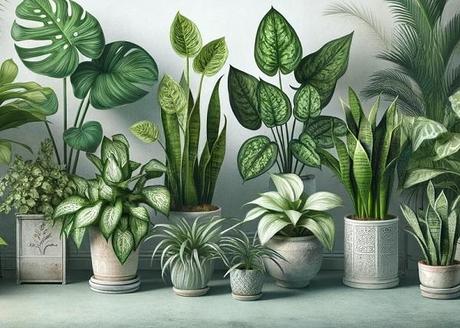
In our modern world, where we spend the majority of our time indoors, the air we breathe inside our homes and offices becomes a crucial aspect of our health and well-being. Unfortunately, indoor air is often laden with unseen pollutants, ranging from everyday household chemicals to microscopic allergens. However, nature offers a simple yet elegant solution to this modern dilemma: indoor plants. Not only do they bring a splash of green and a sense of calm to our living spaces, but many houseplants also have the remarkable ability to purify the air we breathe. This article will introduce you to ten of the best indoor plants known for their air-cleansing abilities. From the lush foliage of the Peace Lily to the striking form of the Snake Plant, each of these natural air purifiers has its unique charm and set of benefits. So, let’s embark on a journey to discover these green heroes that beautify our spaces and contribute to a healthier, cleaner breathing environment.
The Science Behind Plants and Air Purification
Plants are nature’s own air purifiers. Through the process of photosynthesis, they absorb carbon dioxide and release oxygen, contributing to a healthier breathing environment. Additionally, plants are capable of removing toxins like benzene, formaldehyde, and trichloroethylene from the air. This ability was highlighted in NASA’s Clean Air Study, which identified several plants that can detoxify indoor air.
The Top Ten Indoor Plants for Clean Air
Spider Plant (Chlorophytum comosum)
The Spider Plant is an easy-to-care-for houseplant with long, variegated leaves. It’s excellent for removing pollutants like xylene and formaldehyde.
Care: Thrives in bright, indirect light; water moderately.
Snake Plant (Sansevieria trifasciata)
Known for its upright, sword-like leaves, the Snake Plant is a hardy option that excels at filtering out formaldehyde.
Care: Prefers low light; water sparingly.
Peace Lily (Spathiphyllum)
With its glossy leaves and white blooms, the Peace Lily is as beautiful as it is effective in removing ammonia, benzene, formaldehyde, and trichloroethylene.
Care: Thrives in shady areas; keep soil moist.
Aloe Vera (Aloe barbadensis miller)
Aloe Vera is not just for skin care; it’s also effective in filtering out formaldehyde and benzene.
Care: Prefers sunny locations; water when the soil is dry.
Rubber Plant (Ficus elastica)
The Rubber Plant, with its dark green leaves, is a powerful air purifier, especially for removing formaldehyde.
Care: Prefers indirect light; water moderately.
Boston Fern (Nephrolepis exaltata)
This lush fern is particularly good at removing xylene and formaldehyde.
Care: Thrives in high humidity and indirect light; keep soil consistently moist.
Bamboo Palm (Chamaedorea seifrizii)
The Bamboo Palm adds a tropical feel and excels at filtering out benzene and trichloroethylene.
Care: Prefers bright, indirect light; water when the soil feels dry.
English Ivy (Hedera helix)
Ideal for hanging baskets, English Ivy is effective against airborne faecal particles and formaldehyde.
Care: Thrives in moderate temperatures and medium sunlight; keep the soil moist.
Philodendron (Araceae)
With heart-shaped leaves, the Philodendron is a charming addition that’s particularly good at absorbing formaldehyde.
Care: Prefers moderate light; water when soil is dry.
Areca Palm (Dypsis lutescens)
Known for its feathery fronds, the Areca Palm effectively removes toxins and adds moisture to indoor air.
Care: Prefers bright, indirect light; water often.

Tips for Keeping Your Indoor Plants Healthy
Remember to provide the right amount of light and water to ensure your indoor plants thrive and continue purifying your air. Most indoor plants prefer indirect sunlight and require watering when the top inch of soil feels dry.
Benefits Beyond Air Purification
Beyond purifying air, indoor plants offer numerous other benefits. They contribute to a calming environment, reducing stress and promoting mental well-being. Plants also enhance the aesthetic appeal of your home or office, adding a touch of nature to indoor spaces.
Incorporating plants into your indoor environment is a simple yet effective way to improve air quality. The ten plants listed here are not only excellent air purifiers but also add beauty and tranquillity to your surroundings.
Ready to breathe cleaner air and enjoy the tranquillity of nature in your home? Start by adding a few of these air-purifying plants to your space. Whether you’re a seasoned gardener or a plant-care novice, there’s a perfect plant for everyone. Share your indoor plant journey with us in the comments, and let’s grow a greener, cleaner world together!
References and Additional Resources
For those interested in delving deeper into the world of indoor plants and their benefits, we recommend exploring NASA’s Clean Air Study and other resources available online and in libraries.

